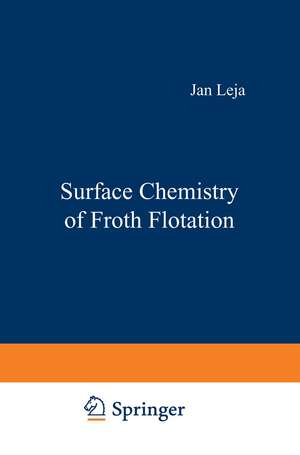Surface Chemistry of Froth Flotation
Autor Jan Lejaen Limba Engleză Paperback – 18 dec 2012
Preț: 965.83 lei
Preț vechi: 1177.84 lei
-18% Nou
Puncte Express: 1449
Preț estimativ în valută:
184.87€ • 200.88$ • 155.39£
184.87€ • 200.88$ • 155.39£
Carte tipărită la comandă
Livrare economică 21 aprilie-05 mai
Preluare comenzi: 021 569.72.76
Specificații
ISBN-13: 9781461579779
ISBN-10: 1461579775
Pagini: 784
Ilustrații: XXI, 758 p.
Greutate: 1.03 kg
Ediția:1982
Editura: Springer Us
Colecția Springer
Locul publicării:New York, NY, United States
ISBN-10: 1461579775
Pagini: 784
Ilustrații: XXI, 758 p.
Greutate: 1.03 kg
Ediția:1982
Editura: Springer Us
Colecția Springer
Locul publicării:New York, NY, United States
Public țintă
ResearchDescriere
The process of froth flotation is an outstanding example of applied surface chemistry. It is extensively used in the mining, mineral, metallurgical, and chemical industries for separation and selective concentration of individual minerals and other solids. Substances so concentrated serve as raw materials for producing appropriate metals and chemicals. The importance of flotation in technology is chiefly due to the ease with which it can be made selective and versatile and to the economy of the process. The objective of this book is to review the fundamentals of surface chemistry together with the relevant aspects of organic and inorganic chemistry that-in the opinion of the author-are important ~ control of the froth flotation process. The review updates the information that had been available in books by Sutherland and Wark (1955), Gaudin (1957), Klassen and Mokrousov (1963), and GIembotsky et al. (1963). It emphasizes mainly the surface chemical aspects of the process, leaving other relevant topics such as hydrodynamics, mechanical and electrical technology, cir cuit design and engineering, operations research, instrumentation tech nology, modeling, etc., to appropriate specialized treatments.
Cuprins
I. Introduction.- 1.1. Scope of Froth Flotation.- 1.2. An Outline of a Mineral Flotation System, Definitions.- 1.3. Typical Flotation Procedures and Flowsheets.- 1.4. Mineral Liberation Size.- 1.5. Some Problems Encountered in Separations of Minerals.- 1.6. Examples of Industrial Separations of Sulfide Minerals.- 1.6.1. Lead-Zinc Ores.- 1.6.2. Copper Ores.- 1.7. Examples of Industrial Separations of Oxidized Ores of Copper, Lead, Zinc, Iron, and “Nonmetallic” Minerals.- 1.7.1. Separations of the Superficially Oxidized and Oxide-Type Minerals.- 1.7.2. Separations of the “Nonmetallic” Industrial Minerals..- 1.8. Separation of “Soluble Salts” from Saturated Brines.- 1.9. Flotation of Silicate Minerals.- 1.10. Separation of Naturally Hydrophobic Minerals.- 1.11. Recent Developments in Industrial Flotation Operations and Research Techniques.- 1.12. Flotation Literature.- 1.13. Selected Readings.- 1.13.1. Flotation Theory.- 1.13.2. Flotation Practice.- 1.13.3. International Conferences.- 1.13.4. List of Periodicals Regularly Publishing Papers on Flotation Theory and Practice.- 1.13.5. List of Periodicals Publishing Occasional Papers on Flotation Chemistry.- 2. Chemical and Molecular Bonding. Interfacial Energetics.- 2.1. Ionic Bonding.- 2.2. Covalent Bonding.- 2.3. Partial Ionic-Covalent Bonds.- 2.4. Dipole Moments and Dipole-Dipole Interactions.- 2.5. Hydrogen Bonding.- 2.6. London Dispersion Forces, van der Waals Interactions.- 2.6.1. Dispersion Forces Between Macroscopic-in-Size Aggregates of Atoms.- 2.6.2. Practical Significance of van der Waals Interaction.- 2.7. Metallic Bonding. Band Theory of Solids.- 2.8. The Importance of Steric (Size) Parameters in Interfacial Bonding.- 2.9. Interfacial Thermodynamics, Definitions and Concepts.- 2.9.1. Thermodynamic Relationships in Chemical and Electrochemical Systems.- 2.9.2. Thermodynamics of Adsorption at an Air/Liquid Interface.- 2.9.3. Thermodynamics of Adsorption at a Solid/Liquid Interface.- 2.9.4. Thermodynamics of Thin Liquid Layers.- 2.10. Interfacial Wetting and Contact Angle Relationships.- 2.10.1. Interpretations of Contact Angle.- 2.10.2. Dynamic Aspects of Wetting and De-wetting.- 2.10.3. Critical Surface Tension of Low-Energy Solids.- 2.11. Liquid/Gas and Liquid/Liquid Interfaces.- 2.12. Selected Readings.- 2.12.1. Chemical and Molecular Bonding.- 2.12.2. Thermodynamics.- 2.12.3. Interfacial Relationships.- 3. Structure of Solids.- 3.1. Atomic Packing.- 3.2. Crystal Structures of Simple Compounds.- 3.3. Structural Changes and Chemical Relationships.- 3.4. Structures Containing Finite Complex Ions.- 3.5. Silicates.- 3.6. Selected Readings.- 4. Water and Aqueous Solutions.- 4.1. Structural Models.- 4.2. Hydration of Ions.- 4.3. Debye-Hückel Model of Ions in Solution.- 4.4. Ion-Pair Formation.- 4.5. Dissociation of Water and Acids.- 4.6. Solubility of Gases in Water.- 4.7. Solubility of Hydrocarbons in Water.- 4.8. Dissolved Mineral Constituents.- 4.9. Antipollution Treatment of Mill and Mine Effluents.- 4.10. Selected Readings.- 5. Flotation Surfactants.- 5.1. Classification of Surfactants.- 5.1.1. Hydrocarbon Groups (R) Nomenclature.- 5.1.2. Less Common Flotation Surfactants, Mono- and Multipolar.- 5.1.3. Commercial Flotation Reagents.- Class I: Thio Compounds.- 5.2. Xanthates.- 5.2.1. Preparations of Alkali Xanthates.- 5.2.2. Aqueous Solutions of Xanthates.- 5.2.3. Insoluble Metal Xanthates.- 5.3. Dithiocarbamates.- 5.4. Mercaptans (Thiols).- 5.5. Dithiophosphates.- Class II: Non-Thio lonizable Surfactants.- 5.6. Dissociation and Hydrolysis.- 5.7. Surface Tension Versus Concentration Relationship.- 5.7.1. Aqueous Solutions of Non-Thio lonizable Surfactants..- 5.7.2. Surface Tension-Concentration Relationships for Surfactants Which Do Not Form Micelles.- 5.7.3. Ideal and Nonideal Mixtures of Soluble Surfactants, Synergistic Effects.- 5.7.4. Dynamic Surface Tension.- 5.8. Krafft Point and Cloud Point.- 5.9. Micelle Structures.- 5.10. Carboxylates.- 5.10.1. Carboxylic Acids.- 5.10.2. Metal Carboxylates (Soaps).- 5.11. Alkyl Sulfates and Sulfonates.- 5.12. Alkyl Amines and Substituted Amines.- Class III: Nonionic Surfactants.- 5.13. Alcohols.- 5.14. Ethers.- 5.14.1. Polyoxyethylene Nonionic Derivatives.- 5.14.2. Polyoxypropylenes and Block-Polymer Nonionic Surfactants.- 5.15. Organic Regulating Agents.- 5.15.1. Cellulose, Starch, and Their Hydrolysis Products.- 5.15.2. Derivatives of Starch and Cellulose.- 5.15.3. Wood Extracts: Quebracho and Wattle Bark, Lignin and Tannin Derivatives.- 5.16. Commercial Flocculating Agents.- 5.17. Selected Readings.- 6. Physical Chemistry of Surfaces and Interfaces.- 6.1. Types of Interfaces. Colloids.- 6.2. Characteristics of a Solid Surface.- 6.3. Adsorption and Its Characteristics.- 6.4. Thermodynamic Models of Isotherms for Physical Adsorption.- 6.4.1. The Henry’s Law Isotherm.- 6.4.2. The Langmuir Adsorption Isotherm.- 6.4.3. Adsorption Isotherms for Mobile Adsorbates.- 6.4.4. Polanyi’s Potential Theory Isotherms.- 6.4.5. BET Theory [Brunauer, Emmett, Teller (1938)] of Multilayer Adsorption.- 6.4.6. Frenkel-Halsey-Hill Slab Theory of Adsorption.- 6.5. Mechanical Effects of Adsorption at Solid/Gas Interfaces.- 6.6. Models of Isotherms for Chemisorption.- 6.7. Characterization of Adsorption from Solutions (in Particular at Solid/Liquid Interfaces).- 6.8. Oxidation of Surfaces of Metals and Metallic Sulfides.- 6.9. Hydration of Surfaces. Thin Films.- 6.10. Insoluble Monolayers of Surfactants at the Air/Water Interface. Interactions Among Surfactants.- 6.10.1. Monolayer Penetration, Molecular Association of Surfactants at the Air/Liquid Interface.- 6.10.2. Solidification of Ionized Monolayers on Reaction with Counterions.- 6.10.3. Interactions Between Surfactants at the Solid/Liquid Interface.- 6.11. Selected Readings.- 7. Electrical Characteristics of Interfaces. Electrical Double Layer and Zeta Potential.- 7.1. Definitions and Electrochemical Concepts.- 7.2. Models of the Electrical Double Layer.- 7.3. Experimental Testing of the Double-Layer Theory (Using an Ideally Polarizable Electrode).- 7.4. Adsorption of Neutral (Nonionic) Surfactants at the Mercury/Electrolyte Interface.- 7.5. Charge Transfer Across the Electrical Double Layer.- 7.6. Semiconductor/Solution Interfaces.- 7.7. Electrical Double-Layer Studies Relevant to Flotation.- 7.8. Electrokinetic Effects.- 7.9. Examples of Zeta Potential Changes.- 7.10. Utility of Electrical Double-Layer and Electrokinetic Data.- 7.11. Selected Readings.- 8. Adsorption of Flotation Collectors.- 8.1. Requirements for Collector Adsorption.- 8.2. Mechanisms of Xanthate Adsorption.- 8.2.1. The Nature of the Adsorbate Species.- 8.2.2. The Critical Role of Oxygen in Sulfide Flotation Systems.- 8.2.3. Flotation Problems Caused by Excessive Surface Oxidation.- 8.3. Mechanisms of Adsorption of Non-Thio Collectors.- 8.3.1. Chemisorption of Carboxylates Accompanied by Physical Coadsorption.- 8.3.2. Molecular Interactions Among Surfactants at Solid/Liquid Interfaces.- 8.3.3. Specific Adsorption of Ionized Collector Species in the IHP (Without Charge Transfer).- 8.3.4. Adsorption of Surfactants to a Network of Polymerized Counterion Complexes, Activating Agents.- 8.4. Adsorption of Surfactants to Highly Soluble Salts in Their Saturated Salt Solutions.- 8.5. Adsorption of Surfactants Leading to Suppression of Floatability.- 8.6. Concluding Remarks on Adsorption Mechanisms.- 8.7. Selected Readings.- 9. Flotation Froths and Foams.- 9.1. Single Gas Bubbles in Liquid.- 9.2. Foams and Froths (Two-Phase Systems).- 9.3. Kinetics of Drainage in Single Films Supported on Frames.- 9.4. Characteristics of Single Thin Liquid Layers (Thin Films). Disjoining Pressure.- 9.5. Theories of Foam and Froth Stability.- 9.6. Destruction (Collapse) of Foams and Froths.- 9.7. Theoretical Conditions (From Analysis of Film Thinning) for Particle-Bubble Attachment (Mineralization of Bubbles)..- 9.7.1. Effects of Surfactants on Induction Time in Particle-Bubble Attachment.- 9.7.2. The Role of Surfactants and Their Diffusion in Particle-Bubble Attachment.- 9.7.3. Withdrawal of Water To Establish the Area of Particle-Bubble Contact.- 9.8. Joint Action of Collectors and Frothers in Flotation.- 9.9. Flotation Frothers: Their Requirements and Mechanisms of Their Action.- 9.10. Mineralized Flotation Froths and Their Stability.- 9.11. Bubble Generation in Mechanical Flotation Cells.- 9.12. Selected Readings.- 10. Inorganic Regulating Agents, Activators, Depressants.- 10.1. pH Control.- 10.2. Control of Charge Density at the Solid/Liquid Interface.- 10.2.1. Sodium Silicate.- 10.2.2. Sodium Polyphosphates.- 10.3. Additives Regulating the Oxidation States of Various Components in the Pulp.- 10.4. Complexing Additives.- 10.5. Hydro Complexes.- 10.5.1. Selective Flotation Using Control of pH.- 10.6. Complexing Additives Containing Sulfide, Sulfite, or Thiosulfate Ions.- 10.6.1. Use of Sulfur-Containing Inorganic Additives in Selective Flotation.- 10.7. Cyanides, Cyanates, Thiocyanates, and Ferrocyanates.- 10.8. Use of Cyanide Ion as a Depressant.- 10.9. Halide Ligands.- 10.10. Closing Remarks—Problems Created by Fine Particles.- 10.11. Selected Readings.- References.













